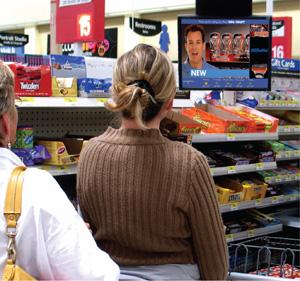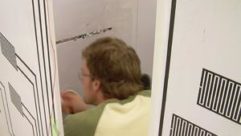

OoH, Look at the Opportunity
In February 2008, newspaper and broadcasting giant Tribune Co. cut its staff by 2 percent amid sharp declines in advertising sales?a chronic problem throughout the newspaper industry over the past few quarters.
IN FEBRUARY 2008, NEWSPAPER AND BROADCASTING giant Tribune Co. cut its staff by 2 percent amid sharp declines in advertising sales—a chronic problem throughout the newspaper industry over the past few quarters. That same month, General Motors announced it would move about half of its $3 billion ad budget out of traditional media, such as magazines and newspapers.THE RIGHT PLACE AT THE RIGHT TIMECOUNTING EYEBALLS
Credit: Premier Retail Networks
Interestingly, those problems could spell opportunities for AV pros.
Over the next three years, GM will shift $1.5 billion into digital marketing, including out-of-home (OoH) media such as digital signage. (For more on this rapidly emerging market, see “Digital Signage: Opportunity Ahead,” page 36.)
And it’s not the only company funneling more money into OoH, which is part of the reason why traditional media outlets are suffering.
“That money is going somewhere,” says Bill Collins, principal of DecisionPoint Media Insights, a research and consulting firm based in Cincinnati that specializes in OoH. “Some of it is going to the Internet, but a lot of it is going out of home.”
Why now?
In a word, fragmentation. Advertisers and marketers realize that as the number of information and entertainment options grows, some of them will start to have less impact on consumers.
For example, newspaper readership is declining as people get more information online, making print a less effective means of reaching the mass market. At the same time, digital signage is showing up in more public places—including supermarkets, restaurants, and subway stations—making it an increasingly attractive advertising vehicle.
“It’s already a $1.3 to $1.5 billion market,” says Suzanne Alecia, president of the Out-of-Home Video Advertising Bureau (OVAB), based in New York. “It’s huge, but it’s dwarfed by what advertisers spend on television, which is about $50 billion for prime time. But people spend more time in front of these OoH networks than at home,” she explains. “What advertisers are looking for is better, more effective places to put their advertising dollars.”
Judging by trends in advertiser spending, they perceive OoH as one of those places. “It’s the fastest-growing industry in terms of advertising spent, behind Internet search,” Alecia says. “A lot of people don’t realize that.”
OoH is a catchall term covering a wide variety of media types and technologies, including digital signage and in-store networks such as Wal-Mart’s. One of the biggest players on OoH is San Francisco–based Premier Retail Networks (PRN), which deploys and operates networks on behalf of retailers such as Best Buy, Costco, and Wal-Mart.
PRN claims a portfolio of about 6,000 stores, which the company says are visited by more than half of the U.S. population each week. That reach is another example of why OoH’s popularity is rising with advertisers.
Another reason: location. Digital signage is often installed in retail environments—it is literally in the right place at the right time to influence shoppers as they’re making buying decisions.
Some OoH video advertising has the surprise factor on its side simply because it shows up in new and unexpected places, such as on a gas pump or above a urinal in the men’s room at a restaurant. That surprise increases the likelihood that consumers will pay attention, at least until the newness wears off.
The OoH market is enabled partly by the wide availability and declining cost of broadband networks, which are ideal for delivering audio and video to signage (and underscore the importance of IT and networking skills for AV integrators looking to get into the OoH space.) Another enabler is declining display costs.
“The cost of technology keeps coming down,” says DecisionPoint’s Collins. “It makes it easier to deploy a thousand screens than it did five years ago, when a screen might cost $8,000.”
But when it comes to OoH, signage is about more than displays and networks. Enterprising AV pros can add much-needed value through software and other technology.
Although advertisers like GM are spending more and more money on OoH, the market is at a disadvantage compared to traditional media in one key respect: audience measurement, the equivalent of radio and TV ratings provided by Arbitron and Nielsen, respectively. Just about everyone from advertisers to display vendors agrees that measurement is key for leveling the playing field between OoH and traditional media.
“It’s something that we talk about a lot: How do we convince customers of the benefit of digital signage?” says Kevin Schroll, senior product planning manager for monitors at Mahwah, N.J.–based Sharp.
It’s the question that led to the founding of OVAB in January 2007.
OoH, Look at the Opportunity
In February 2008, newspaper and broadcasting giant Tribune Co. cut its staff by 2 percent amid sharp declines in advertising sales?a chronic problem throughout the newspaper industry over the past few quarters.
WHO’S WATCHING WHAT?
“Our mission is to put together standards and metrics that make it easier for advertisers and advertising agencies to evaluate, plan, and buy all of these different networks,” Alecia says. “Those don’t exist today. Different companies are using different measurements to come to their audience numbers. What the advertisers and agencies want is a comparable set of data.”
In the meantime, some large signage networks have turned to third parties to compile the data just for them. In 2004 and 2005, PRN hired Nielsen to measure Wal-Mart Television Network. Nielsen reported 49,024 gross impressions per store, a 9 percent increase in overall viewership over 2004. The growth was even higher among some demographics, such as Wal-Mart’s core demographic of females, whose viewership increased 24 percent.
There’s also ample research into the effectiveness of digital signage in general, regardless of its network One example is MediaWeek‘s comparison between digital signage and traditional media.
“It shows that digital signage ads catch attention 63 percent of the time compared to billboards at 58 percent, magazines at 57 percent, TV at 47 percent, Internet at 40 percent, and radio at 37 percent,” says Dan Woodward, a senior product manager at Walnut, Calif.–based ViewSonic. “It also listed digital signage as the most interesting and unique; only TV was rated more entertaining. I think this shows the entry of a new media into the traditional advertising market.”
But as impressive and useful as such data are, they only provide advertisers and media buyers with part of the picture. For example, media professionals also want information about other signage networks, and they want it compiled using an industry-standard methodology that allows them to make apples-to-apples comparisons between those networks.
“For the agencies and advertisers to evaluate that efficiently, there has to be a common ground for how those numbers are calculated,” Alecia says. “That’s really important for our industry.”
As the OVAB creates the framework, it’s soliciting input from the companies that eventually will use it. “We’ve developed an agency advisory board,” Alecia says. “That makes sure that they’re happy with the way we’re going.”
Until OoH has an established, widely used measurement system, there are a few other ways to help advertisers measure effectiveness. A technique that’s common in Europe and starting to show up in North America is the use of wireless “short codes”— five- or six-digit codes that are included with digital ads. Passers-by can use their cell phones to send a text message to the code and receive a message with more information about the advertised product or an electronic coupon. The number of incoming messages gives the advertiser a rough idea of how many people have seen it.
Another technique is to add a camera or other sensor to the display in order to count the number of people who are within eyeshot of the ad. Depending on the sophistication of that sensor, it also may be possible to weed out the number of people who actually viewed the ad versus those just passing by.
That ability often is referred to as “eye gaze” technology, and it can be used to identify not only whether a person looks at the display, but also for how long. The latter can be particularly valuable for advertisers because, for example, it’s feedback about whether people find the ad compelling.
“Those are better than the Nielsen numbers—a lot better,” says DecisionPoint’s Collins.
One thing is clear: More numbers are key to OoH’s continued growth.
“Money follows where the eyeballs go,” says OVAB’s Alecia. “If you can quantify where those eyeballs are going, the dollars will follow.”
Tim Kridel is a freelance writer based in Columbia, Mo. He can be reached at [email protected].










